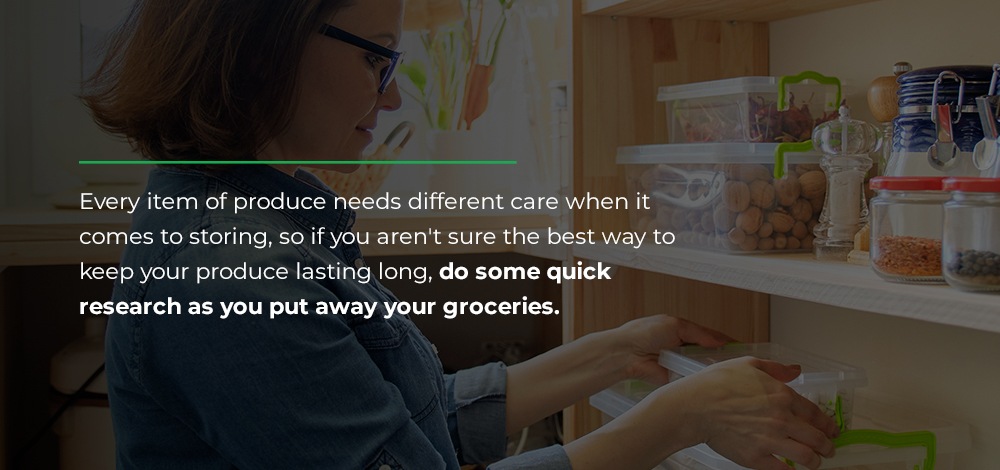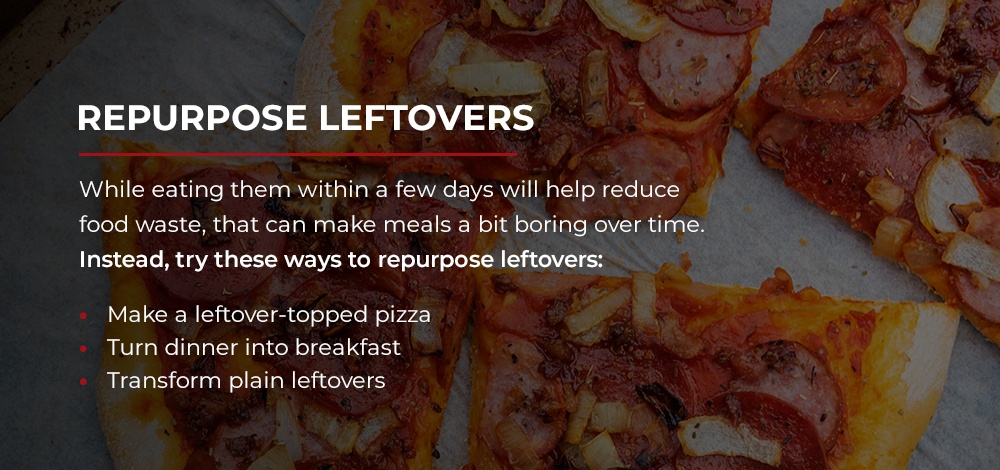5 Tips to Avoid Wasting Food
If you’ve ever found a container of leftovers pushed to the back of the fridge to be forgotten or thrown out a bag of wilted or rotten produce, you know how common food waste is. In fact, the United States Department of Agriculture (USDA) estimates between 30 to 40% of our food supply becomes food waste. While much of that waste comes from stages throughout the farm to retail process, households also contribute, but you can reduce your food waste.
Limiting food waste is better for your budget, and it can also be better for the environment. Learning some tips to avoid wasting food will help you stretch your food budget and avoid filling landfills with food waste, and it’s easier than you might think.
No matter the size of a household, we often wonder how we can stop wasting food. Learning a handful of tips for reducing food waste will help answer that question. Check out our list below and comment with ways that you and your family reduce food waste!
1. Buy What You Need
One of the best ways to avoid wastage of food is to prevent yourself from buying too much. If you go into the grocery store with a vague list or without a clear plan, you’re probably going to buy more than you need. That means some of what you buy will go uneaten, ending up in the trash not long after you shop. And that can impact your budget over time.
If you can, making a few grocery trips a week will help you minimize what you buy. You should also avoid buying food items, especially perishable food items, in bulk if you can. We know that’s not always an option for everyone, so whenever and however you do your grocery shopping, you should follow these tips:
- Get what your family likes.
- If you’re trying something new, don’t buy too much.
- Create a clear grocery list, including amounts of what to buy.
- Use meal prep and meal planning to help create your grocery list.
- Cook and shop using recipes so you don’t buy too much.
2. Learn How to Store Food
Storing food incorrectly leads to quicker spoiling, and that means you’re wasting food. Once you bring your groceries home, you need to know how to store them with tips like:
- Keep potatoes, tomatoes, garlic, onions and cucumbers out of the fridge and at room temperature.
- Store raw meat in sealed containers at the bottom of your fridge.
- Use clean, high-quality food storage containers.
There are even certain produce items that you shouldn’t store together. Separate foods that produce ethylene gas, which promotes ripening, from those that are sensitive to it and can over-ripen. Bananas, avocados, tomatoes, green onions, peaches and more create ethylene gas while potatoes, apples, berries and other fruits and veggies are sensitive to it.

Every item of produce needs different care when it comes to storing, so if you aren’t sure the best way to keep your produce lasting long, do some quick research as you put away your groceries.
When you store and handle food, remember the temperature danger zone. The USDA recognizes the danger zone as temperatures between 40°F to 140°F. Make sure your fridge is colder than 40°F and that you cook food above 140°F to help food last longer and be safe to eat. That rule primarily applies to high-risk foods, such as:
- Raw and cooked meat
- Seafood
- Dairy products
- Eggs
- Cooked grains, like rice and pasta
- Prepared salads
- Ready-to-eat foods
Keep a thermometer in your fridge for a reliable read on the temperature inside, especially if you’re storing a lot of high-risk foods. Use a thermometer when you cook to get your food to the right temperature, as well. Those steps will help ensure that, if you do have leftovers, you cook and keep them within safe temperatures.
3. Freeze What You Can or Buy Frozen Ingredients
One of the best ways to save food is to freeze it, and luckily, you can freeze just about any food. The USDA says some of the few exceptions to what you can freeze include eggs in their shells and canned food. But once you open those canned goods, you can often freeze the contents. Research food on a case-by-case basis and consult product packaging to see whether it’s safe to freeze.
Buying already frozen foods will take out the guesswork. Maybe you don’t use produce often enough to warrant always buying fresh. Instead of throwing away your money, get frozen ingredients instead. Fruits and vegetables, in particular, keep for a while in the freezer. Plus, if you get frozen fruit that was picked and frozen at peak ripeness, it’ll maintain its nutritional value. Try not to keep frozen produce for over a year, though, as that can reduce nutrient levels.
To help keep your food at a safe temperature and help protect its lifespan, get refrigerated and frozen foods at the end of your shopping trip. Get those foods in your fridge or freezer as soon as you get home. If you live far from the store or it’s a hot day, bring some insulated cooler bags and ice packs to help cold foods survive the trip.
Remember not to thaw then re-freeze foods. That gives bacteria the chance to grow, but the risk changes depending on the food, how you handle it and other factors. Still, it’s best practice to cook and use whatever you thaw to prevent food waste.
4. Be Mindful as You Cook
If you don’t often measure out what you’re cooking and just make everything that comes in a package, you risk creating food waste with excess leftovers. Using the recommended portions and checking the serving sizes of recipes will help keep you from making too much food that could go to waste. Be mindful as you cook with these other ways to save food and reduce food waste:
- Who you’re cooking for: If you have a family of four, many recipes are geared towards you in terms of serving size. As long as everyone gets the right portion, you should have just enough food. But if you’re having guests over or you have a larger family, you may have to double-up recipes accordingly. With a smaller family, you may need to halve a recipe so you don’t make too much.
- What you’re cooking: Some meals are so filling that your family will only eat the recommended serving. Others may warrant a second helping or side dishes. Think about what you’ll be serving with your main meal, if anything, and factor that into serving sizes and how much you cook so you don’t waste food.
- What ingredients you need: Maybe you need a small amount of an ingredient for one recipe that you don’t plan on using again. Check the portion and serving size of your recipe then buy the smallest size available of that ingredient. If you still have some left and it’s a perishable food item, research other recipes to try so you don’t waste an ingredient.
5. Repurpose Leftovers

Even if you plan your meals and shopping lists, you may still end up with leftovers. While eating them within a few days will help reduce food waste, that can make meals a bit boring over time. Instead, try these ways to repurpose leftovers:
- Make a leftover-topped pizza: For a sausage and roasted veggie pizza, combine leftover roasted veggies with sausage, remembering to cook to 160°F. Top your premade pizza crust with your favorite sauce, cheese and the toppings to repurpose some leftovers into a delicious pizza.
- Turn dinner into breakfast: Make sausage, peppers and onions on a sheet pan for dinner, and the next morning, serve the dish with eggs for a hearty breakfast. Repurpose other leftovers in similar ways to make breakfast in the morning simple and delicious.
- Transform plain leftovers: Take cooked foods that are a bit on the plain side and turn them into delicious meals. Hard-boiled eggs can become delicious sausage Scotch eggs and cooked rice can turn into rice sausage patties.
You can also make leftovers a part of a new meal by adding side dishes, starches, vegetables, meat or whatever is missing from your leftovers to make a complete meal. Whether you repurpose leftovers or eat them as they were, storing them correctly can also help reduce food waste. Follow these tips for storing your leftovers to avoid food waste or dangerous conditions:
- Refrigerate leftovers within two hours of cooking.
- Store leftovers in quality, air-tight containers.
- Use clear containers so your family knows what’s what and will want to eat it.
- Label your leftovers with the date and what’s in the container.
- Keep leftovers visible in your fridge or freezer so they don’t get forgotten.
- Use most leftovers within three to four days.
- Throw out leftovers once a week.
Find Premio Sausage in a Store Near You
Use some of those ingredients you can’t keep for much longer in recipes from Premio. Satisfy the entire family with ingredients from Premio that are sure to leave no leftovers or food waste behind. We have over 40 years of experience crafting a variety of sausages from tradition to give your family fresh and familiar flavors. Premio products contain no fillers, meaning you can feel good about serving them to your family, whether you’re transforming leftovers or making something new.
Find Premio in a store near you or check out our products to learn more!
